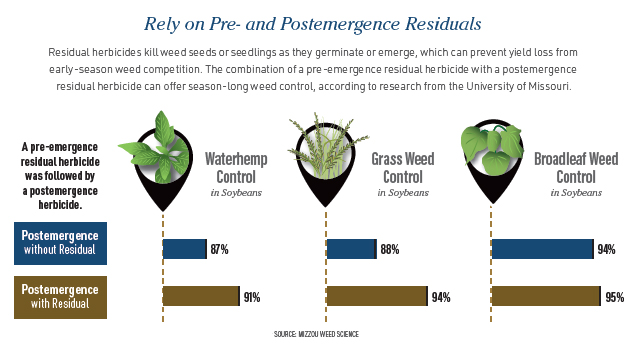Weed Control In A New World Order

Consider these strategies if your former plan isn’t an option
Supply chain constraints could limit the amount — or dramatically increase the price — of key weed control products such as glyphosate and glufosinate in 2022. Prepare for if these options are not in the cards.
“Glyphosate made weed control simple before we had glyphosate- resistant weeds” says Bill Johnson, Purdue University weed scientist. “There aren’t simple answers now. It’s time to become a weed scientist student again.”
Consider these strategies:
1. MAKE A PLAN B NOW.
Sure, the supply chain could be repaired by the spring, and you have standard weed control products available to you, but making that your plan brings great risk, Johnson says.
“If in May farmers are asking their retailers or custom applicators to spray alternative products on short notice, we will have chaos,” he says.
As you consider alternative products, make sure they are effective against the common weeds you see most. Note their application windows and instructions.
You will also want to consider the role of non-herbicidal control options, adds Kevin Bradley, University of Missouri weed scientist. For example, if you only have a certain amount of product, you might want to couple it with tillage or cultivation.
2. MAKE EVERY SPRAY COUNT.
If you can only spray a product one time, Johnson says, where or when will you get the best results? Rank your field by previous weed pressure.
“Now is the time to be better stewards of our chemicals,” Bradley says. “We can’t afford to go out there with the wrong rates, wrong nozzles or wrong adjuvants.”
3. FOCUS ON RESIDUALS.
Instead of relying on managing weed escapes, Johnson says, make residual herbicides the backbone of your 2022 weed management program (see below).

“If you’re the one person who doesn’t like residual herbicides, you need to change,” Bradley says. “You need to rely on residual pre- and postemergence herbicides.”
In corn, if you have residuals do the bulk of your weed suppression, you still have options for post-weed escapes. Those can include Group 2, Group 4 and Group 27 herbicides.
4. FOLLOW BEST PRACTICES.
Regardless of if you’re stretching your favorite herbicides or trying new ones, Johnson and Bradley recommend these best practices:
- Watch your chemical mixing order. Some chemicals are not compatible with other components in the spray mixture, such as other herbicides, fertilizers, biologicals, fungicides or insecticides.
- Think about off-target movement and know your likelihood of drift and damage to neighboring crops.
- Review carrier volume instructions and set your sprayer correctly. Some products require low and some require high volumes. Some products have specific instructions about spray droplet size as well.
- Target labeled rates on small weeds rather than higher rates on big weeds. Products such as glyphosate, dicamba and 2,4-D were more forgiving on large weed sizes.







